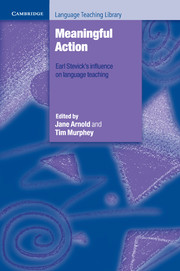Book contents
- Frontmatter
- Contents
- List of contributors
- Acknowledgements
- Preface
- Introduction
- Part A Meaning-making inside and between the people in the classroom
- Part B Meaningful classroom activity
- Part C Frameworks for meaningful language learning
- Epilogue: A way with words – perspectives on the contributions and influence of Earl W. Stevick
- Appendix: Words of tribute to Earl Stevick
- Index
12 - Complex systems and technemes: learning as iterative adaptations
Published online by Cambridge University Press: 15 November 2023
- Frontmatter
- Contents
- List of contributors
- Acknowledgements
- Preface
- Introduction
- Part A Meaning-making inside and between the people in the classroom
- Part B Meaningful classroom activity
- Part C Frameworks for meaningful language learning
- Epilogue: A way with words – perspectives on the contributions and influence of Earl W. Stevick
- Appendix: Words of tribute to Earl Stevick
- Index
Summary
Introduction
It was in 1959 that Earl Stevick first used the word ‘technemic’. ‘Technemic’ is a portmanteau, a combination of the words technique and emic. Stevick coined the term to introduce a concept in language teaching, one that I have made significant use of in my own teaching and in my work with teacher interns.
While the meaning of ‘technique’ is well known, perhaps ‘emic’ warrants an explanation. In a footnote to his article, Stevick acknowledges his debt to Kenneth Pike for the term ‘emic’. Pike was my professor at the University of Michigan, and perhaps that is also why the technemic concept has been so meaningful to me. Pike contrasts an emic approach with an etic approach. The emic approach analyses data in a way which is meaningful to the participants of a community, whereas the etic approach interprets data with reference to an outside perspective or external system. The terms are most often applied in phonology, contrasting sound differences that are phonemic and ones that are phonetic. For example, a phonemic difference exists in English in the contrast between the phonemes /p/ and /b/. The contrast is meaningful to English speakers because the use of /p/ or /b/ results in a meaning difference in, for example, distinguishing pin from bin. A phonetic difference, on the other hand, does not result in a meaning contrast. For example, in English the first /p/ in pot is aspirated, is accompanied by a puff of air, whereas a non-initial /p/ is, as in spot, unaspirated. The contrast can be attested to by the outside perspective of linguists, but participants in the community of English speakers do not even notice the contrast because it is not a meaningful one, although the difference between aspirated /p/ and unaspirated /p/ constitutes a meaning difference, in other languages, such as Thai. The phonemic difference between /p/ and /b/ in English and the phonetic difference between unaspirated and aspirated /p/ are both real contrasts, but only the former is meaningful to English speakers.
Utilizing the terms and concepts, Stevick suggests that teachers can manipulate an activity in such a way that even the slightest alteration in a technique can potentially make for an emic difference, a meaningful difference, in how the activity is perceived by the students in a classroom community.
- Type
- Chapter
- Information
- Meaningful ActionEarl Stevick's Influence on Language Teaching, pp. 190 - 201Publisher: Cambridge University PressPrint publication year: 2013
- 1
- Cited by



